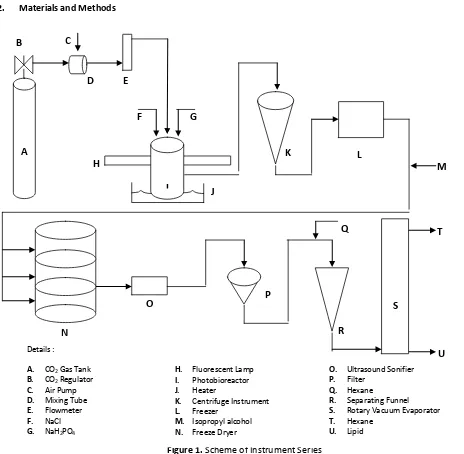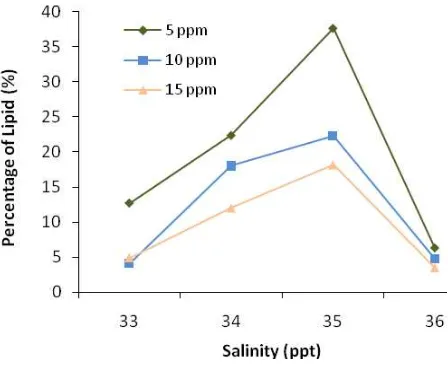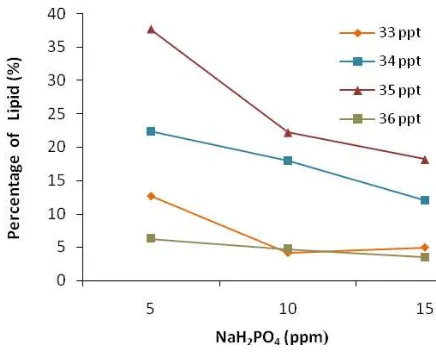The Determination Of Salinity Profile And Nutrition
(Nah
2
po
4
) Profile In Utilizing
Nannochloropsis oculata
To Gain Maximum Lipid
Elida Purba, Kenjiro Siburian
Chemical Engineering Department, Faculty of Engineering, University of Lampung, Jl. Prof Soemantri Brojonegoro No.1, Gedong Meneng, Bandarlampung, INDONESIA
E-mail : [email protected]; [email protected]
Abstract :
The determination of salinity profile and nutrition (NaH2PO4) profile in utilizing Nannochloropsis oculata to gain maximum lipid was
investigated. The purpose of carrying out this research is to determine the optimum salinity and the optimum nutrition (NaH2PO4) to gain
maximum lipid contained in Nannochloropsis oculata. Phosphor as a nutrition can be obtained by adding NaH2PO4 and a salinity
enhancement can be applied by adding NaCl to the culture.This research was run by using variable of salinity (33, 34, 35, and 36 ppt) and variable of NaH2PO4 (5, 10 and 15 ppm). The results show that the percentage of maximum lipid in Nannochloropsis oculata was obtained
when the salinity of 35 ppt and 5 ppm NaH2PO4 is 37,68%. However, this maximum lipid percentage is low and it can be caused by many
factors, such as the drying temperature for preparing the dry microalgae to extract, the cell disruption method and the extraction solvent used in the research. By seeing the result, salinity can affect the total lipid contained in Nannochloropsis oculata. The higher the salinity contained in culture the higher the lipid contained in Nannochloropsis oculata. Otherwise, a different respond was obtained by adding NaH2PO4. If NaH2PO4 concentration is higher, the lipid contained Nannochloropsis oculata will be lower.
Keywords:Nannochloropsis oculata, maximum lipid, nutrition (NaH2PO4), salinity
1. Introduction
Microalgae is a kind of microorganism which capable of utilizing light to react water with CO2 then the
biomass produced (photosynthesis). Microalgae has a big potential to be converted to some beneficial products for human, such as food materials, feed for animals, medicines, and energy [1].
The concept of material selection in producing biodiesel is intended to fulfill a lack of materials. Microalgae is observed as one of the materials for producing biodiesel. Furthermore microalgae is one of the natural resources in Indonesia. Microalgae contains of high lipid content, even some of this microorganism have a lipid content more than 50%. A high lipid content identify how high the fatty acid in microalgae. The higher a fatty acid content in a material, the higher the potential of the material converted to a biodiesel.
Lipid is one of the microalgal components which depends on the a kind of microalgae and a growth condition. Lipid content is ranged between 2-60% of dry weight [2]. Some of them which able to be converted to vegetal oil are Chlorella (32%), Dunaliella (23%), Isochrysis galbana (35%), dan Nannochloropsis oculata (68%). Lipid can be utilized as a material for producing a liquid fuel. Triglyceride and fatty acid which is a lipid component can be converted to methyl ester. Methyl ester produced has some excellences if it is compared with fossil energy. The e elle es are it’s re e a le, iodegrada le, a d lo pollutio . A lipid produ tio is influenced by the nutrition availability and light intensity. Some microalgae can produce lipid in a big amount when it lacks of nutrition. One of the nutrition that usually used is urea [3].
Nannochloropsis oculata has a high lipid content (31-68%) [1]a d it’s ee ulti ated i La pu g pro i e.
result of the influence of a culture condition. Environment can influence the lipid content in microalgae [5]. Furthermore a lipid content in microalgae can be influenced by some nutritions (phosphor, nitrogen, sulphur, iron, ammonia, etc.) [3] and a salinity change. Phosphor as a nutrition can be obtained by adding NaH2PO4 and a salinity
enhancement can be applied by adding NaCl to the culture. Lipid contained in microalgae is potential as a raw material of producing biodiesel. The lipid enhancement can be influenced by some environments, such as salinity and nutrition.
Some factors that influence a cultivation and lipid contained in Nannochloropsis oculata are light, CO2
concentration, nutrition, salinity, pH and temperature. To produce a maximum lipid in Nannochloropsis oculata it needs a light intensity of 4000 lux [6], CO2 concentration of 2% [7], 40 ppm urea [8], temperature of 25
to gain the maximum lipid in Nannochloropsis oculata.
The materials used are Nannochloropsis oculata, an ozonisated sea, NaH2PO4, urea (NH2COONH2), NaCl, CO2,
air, isopropyl alcohol and hexane. The instruments used in this research are photobioreactor (diameter of 10 cm and height 23,5 cm), refractometer (ATAGO S/Mill-E), air pump, CO2 gas tank, CO2 regulator, gas flowmeter,
fluorescent lamp of 20 Watt, digital scale, luxmeter (TENMARS TM-204), mixing tube, heater, haemocytometer, microscope (OLYMPUS CX31), ultrasound sonifier (BANDELIN Sonorex Technik), centrifuge instrument, rotary vacuum evaporator (BUCHI R 210), freezer, freeze dryer (SCANVAC) and separating funnel. The instrument series can be seen in Figure 1.
When starting to cultivate Nannochloropsis oculata, 40 ppm urea and 5 ppm NaH2PO4 is added to the culture
and cultivation is applied at salinity of 33 ppt. The cultivation is applied until the cell density of Nannochloropsis oculata reach exponential phase then the cultivation time is obtained. Afterward the determination of cultivation time is applied for the other 11 variations The cultivations for every variation is repeated by applying the cultivation time. After the culture is centrifuged, it is freezed by using a freezer then water is separated by using freeze dryer until a dry biomass is obtained. The dry biomass is dissolved in 20 ml of isopropanol and it is put in ultrasound sonifier to disrupt the cells. The mixture of dry biomass and isopropanol is separated by screening it. The result is mixed with 20 ml of hexane and then hexane is separated from isopropanol. The addition of hexane is continuously applied until hexane has no change in colour. The lipid is separated from hexane by evaporating it using vacuum evaporator series.
Analysis of lipid percentage is applied by measuring a dry mass of biomass and a lipid mass. A percentage of lipid is determined by dividing a lipid mass and a dry mass of biomass. Percentage of lipid obtained in every variation is compared then the maximum lipid contained in Nannochloropsis oculata is obtained.
3. Results and Discussion
According to the obtained data of each cultivation, the results using Nannochloropsis oculata with CO2
concentration of 2%, light intensity of 4000 lux, nutrition (NaH2PO4) concentration of 5, 10 and 15 ppm, and
salinity of 33, 34, 35 and 36 ppt can be seen in Table 1.
Table 1. Data of optimum salinity dan nutrition (NaH2PO4) determination to gain maximum lipid in Nannochloropsis oculata
Figure 2. The profile of salinity to gain the maximum lipid in Nannochloropsis oculata
The higher the salinity in the culture of Nannochloropsis oculata, the higher the percentage of lipid until it reached 35 ppt. At the salinity of 36 ppt, the percentage of lipid decreased for each NaH2PO4 o e tratio . It’s
caused by the hypersaline condition in culture and Nannochloropsis oculata ould ’t adapt it ell. This o ditio
then affect the lipid contained in Nannochloropsis oculata.
This result is compared to a research carried out by [10]. This research has a purpose of knowing the influence of salt concentration added to Dunaliella tertiolecta culture to lipid contained in microalgae. An increase of NaCl concentration from 0,5 M until 1 M results a different lipid content, 60% for the addition of 0,5 M NaCl and 67% for the addition of 1 M NaCl. The researcher reported that the high intra cell lipid accumulation was suspected as a respond of cell to keep growing over the high salinity in culture. This phenomena run simultaneously with the production of glycerol in some microalgae as the form of cell adaptation to an extreme environment, especially a hypersaline culture. Intracellular glycerol concentration is directly related to the external concentration of salt. Another research [11] was carried out with the purpose of knowing the influence of salinity to the growth and lipid contained in microalgae. The researcher reported that the inhibited malate enzyme formation probably can result a very low lipid productivity. The genetic ability in microalgae to produce a malate enzyme is needed for lipid accumulation. Furthermore the researcher reported that Chlamydomonas sp. produce a moderate lipid content at a low salinity, but a low lipid content is produced at a high salinity. Nevertheless Tetraselmis sp. and Dunaliella tertiolectaprodu e a higher lipid o te t at a high sali it . B seei g the results, the resear her ould ’t state that
salinity can influence malate enzy e a ti it or ot. Therefore it’s e essar to arr out a resear h ith a purpose of knowing that salinity can inhibit the enzyme activity or not. In research [12], it was reported that the formation of β-ketoacyl-conzyme A (CoA) is increased by adding 0,5 M NaCl to 3,5 M NaCl. β-ketoacyl-conzyme A (CoA) is a coenzyme A which has a function to accelerate the first step and rate-limiting step in a chain elongation of fatty acid. To adapt to the hypersaline environment, Dunaliella salina need to modify the composition of a fatty acid. Analysis of lipid showed that microsome (not a plasma membrane or thylakoid) in the microalgae at the addition of 3,5 M NaCl contained a higher ratio of 18C to 16C than when 0,5 M NaCl was added to the culture. The higher the ratio of 18C to 16C, the higher the lipid content in microalgae. Figure 2 shows that there is a significant de rease of a lipid o te t at the sali it of 36 ppt. the ause of the sig ifi a t lipid de rease still a ’t e defi ed.
Figure 3. The profile of nutrition (NaH2PO4) to gain the maximum lipid in Nannochloropsis oculata
Figure 3 shows how NaH2PO4 influence the lipid in Nannochloropsis oculata. It shows that the higher
NaH2PO4 added to the culture, the lower the percentage of lipid. A decrease in the percentage of lipid was
happened because when lipid in an excess condition, the path of the lipid metabolism will be reversible (at the path of glycolysis) and form glucose-6-phosphate. It was supported by the addition of phosphor in a big amount in the culture so the excess lipid was gained. In glycolysis, phosphor is used to form adenosine triphosphate (ATP) then this product is used in every step in glycolysis. If phosphor existed to the culture was enough, an excess lipid will not be gained and the maximum lipid can be reached [13]. The result then compared to a research carried out by [14]. In this research, a different phosphate concentration was added to the culture of Dunaliella salina (30 ppm, 20 ppm, 10 ppm and 5 ppm). The highest lipid content gained is 13% when the addition of 10 ppm phosphate. By comparing the results, it can be concluded that if the phosphor added to culture is lower in the concentration, the percentage of lipid will be higher.
The lipid percentage contained in Nannochloropsis oculata is 38%-60%. Nevertheless the maximum lipid percentage in Nannochloropsis oculata gained in this research is 38,67%. It can be caused by the method used when preparing the dry microalgae to the extraction step.
The reason why a low percentage of lipid is gained has been showed by the former researches. One of the researches is a research carried out by [15]. The results show that lipid contained in microalgae can be influenced by a drying temperature. In this research, the drying temperature used are 0oC, 60oC, 80oC and 100oC. The maximum lipid was gained at 0oC, 52.5% and the lowest one was gained at 80oC, 48.75%, so that it can be stated that the highest lipid content is gained at a low drying temperature.
The drying temperature used is 80oC and by comparing the results, it can be concluded that a low lipid percentage can be caused by a drying temperature.
Furthermore a cell disruption method used can influence a microalgal lipid content. Cell disruption is a method which used to break the cell wall. In a research carried out by [16], cell disruption method of autoclaving, bead-beating, microwaves and sonication was applied to Botryococcus sp., Chlorella vulgaris and Scenedesmus sp. The result shows that by using microwaves method, the highest lipid percentage was gained after the microalgae was extracted. Meanwhile the lowest lipid percentage was gained by using sonication method.
The method used for the cell disruption in this research is sonication method and it can be concluded that a cell disruption method can cause a low lipid percentage.
ore tha he a e. Ne ertheless there’s a literature that for a safet reaso it’s etter to use isoprop l al ohol hexane than chloroform (carcinogenic).
The solvent used in this research is isopropyl alcohol-hexane.It can be concluded that a solvent selection can result a low lipid percentage.
4. Conclusions
Based on the results, the conclusion are as follows:
a. The maximum lipid in Nannochloropsis oculata obtained at the salinity of 35 ppt and the addition of 5 ppm NaH2PO4 is 37.68%
b. At the salinity of 36 ppt, Nannochloropsis oculata is not able to adapt so that the low lipid content is obtained c. At the addition of 15 ppm NaH2PO4, the microalgal lipid content is the lowest in this research
References
[1] Chisti Y. 2007. Science Direct : Biodiesel from Microalgae, 25 : 294-306
[2] Wijffles R. 2006. Energie Via Microbiologie : Status en Toekomstperspectief voor Nederland. Utrecht, Senternovem [3] Wang B, Li, Yanqun, Wu, Nan, Q, Lan, Christopher. 2008. Applied Microbiology and Biotechnology : CO2 Biomitigation
Using Microalgae, 79 : 707-718
[4] Ismi S, Sutarmat T. 1996. Journal of Indonesian Fishery Research : Fatty Acid Composition of Rotifer Enriched with Nannochloropsis oculata at Different Time of Enrichment, 2 : 63-67
[5] Borowitzka MA, Borowitzka LJ, Kessly D. 1990. Journal of Applied Phycology : Effects of Salinity Increase on Carotenoid Accumulation in The Green Alga Dunaliella salina, 2 : 111-119
[6] Budiman. 2009. Determination of Optimum at Growth and Lipid Rate Microalgae Nannochloropsis oculata. FMIPA ITS, Surabaya
[7] Yi CS, Ya KC, Ta TM, Chin OS, Hsun CC, Sheng LC. 2009. Bioresource Technology : Lipid Accumulation and CO2 Utilization of Nannochlropsis oculata in response to CO2 Aeration, 100 (2) 833-838
[8] Wijaya. 2006. The Influence of Adding Urea to The Growth of Nannochloropsis oculata. Universitas Airlangga, Surabaya [9] Converti, Attilio, Allesandro, Erika O, Patrizia P, Marco DB. 2009. Chemical Engineering and Processing : Effect of
Temperature and Nitrogen Concentration on The Growth and Lipid Content of Nannochloropsis oculata and Chlorella vulgaris for Biodiesel Production, 48 : 1146-1151
[10] Takagi et al. 2006. Journal of Bioscience and Bioengineering : Effect of Salt Concentration on Intracelular Accumulation of Lipids and Triacylglyceride in Marine Microalgae Dunaliella Cells, 101 (3) : 223-6
[11] Sonnekus MJ et al. 2010. Effects of Salinity on The Growth and Lipid Ten Species of the Swartkops Saltworks: A Biodiesel Perspective. Nelson Mandela Metropolitan University, South Africa
[12] Azachi M, Sadka A, Fisher M, Goldshlag P, Gokhman I, Zamir A. 2002. Review of Plant Physiol :Salt Induction of Fatty Acid Elongase and Membrane Lipid Modifications in The Extreme Halotolerant Alga Dunaliella salina,129 : 1320-1329 [13] Gunstone FD, Harwood JL, Dijkstra AJ. 2007. The Lipid Handbook (3rd Edition). CRC Press, Boca Raton
[14] Sunarko S. 2010. Effect of Medium Phosphate Concentration in Dunaliella salina Growth, Lipid Content, and Fatty Acid Characteristic on Variated Harvesting Time. ITB, Bandung
[15] Widjaja A. 2009. Makara of Technology Series : Lipid Production from Microalgae as a Promising Candidate for Biodiesel Production, 13 (1) : 47-51
[16] Lee. 2009. Bioresource Technology : Comparison of Several Methods for Effective Lipid Extraction from Microalgae, 101 (1) : S75-S77



